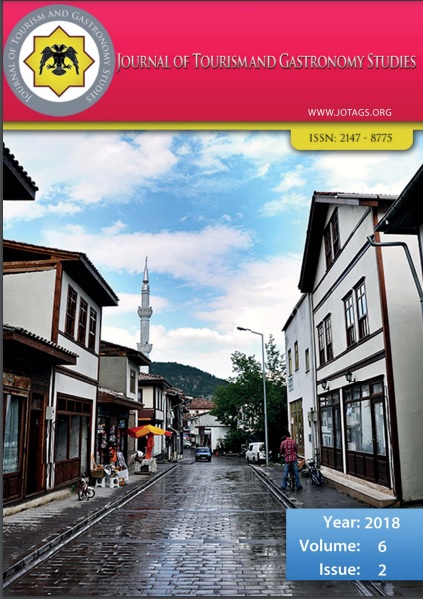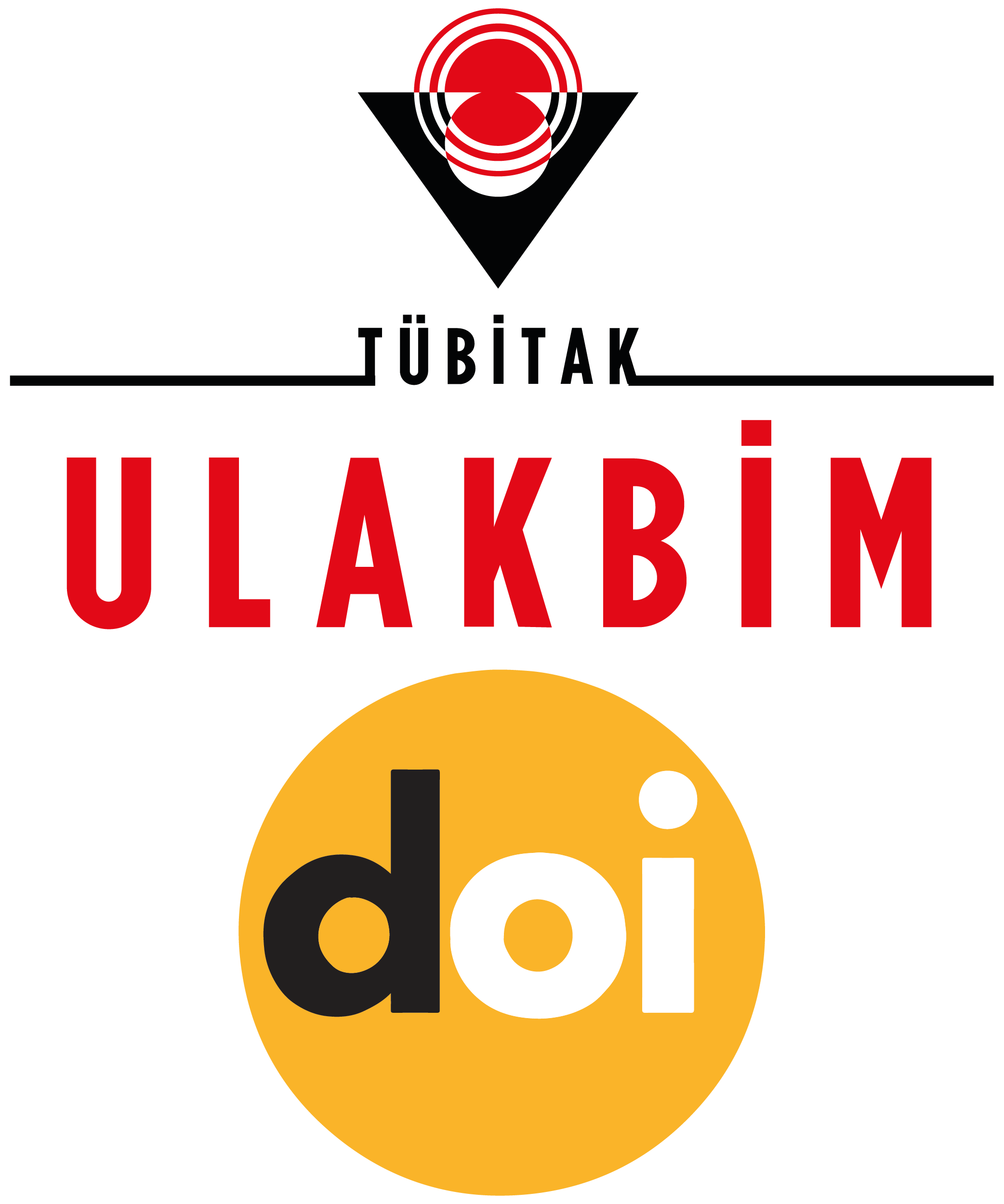Awareness Level of Kyrgyz Cuısine in the Context of Gastronomy Tourism: University Student Examination
Keywords:
Cultural heritage, Tourism, Kyrgyz Cuisine, Tourism students, AwarenessAbstract
Authentic products and cultural elements are increasing values in terms of tourism and they are the main targets in tourists' selection of destinations. Cuisines, a cultural element, are an important source of cultural tourism and have become extremely effective in selecting tourists destinations. Local cuisine, which preserves authentic features and sheds light on the civilization of the societies from past to present, is very important for tourism. For this reason, local cuisine is an important marketing element for countries that want to attract tourists. In order for national kitchens to be regarded as touristic products, first it is necessary for the public to have awareness about the touristic value of their kitchens and to be aware of the marketing of local kitchens for touristic purposes. People who do not know their own touristic resources, we could not expect them usşng these resources for tourism purposes. Based on the results of present study, It is observed that the awareness level of Kyrgyz students about Kyrgyz kitchen is high, and the tasting and enjoyment rates of Kyrgyz kitchen products are also very high. The students approve Besparmak and boorsok as symbolic foods to represent Kyrgyz cuisine in gastronomic tourism. Furthermore it is seen that the motivation of students for vacation is also very high.
References
Adema, P. (2000). “Journal of American and Comparative Cultures”. Bowling Green Vol. 23, Iss. 3, (Fall ): 113-
Akgöl, Y. (2012). Gastronomi Turizmi ve Türkiye’yi Ziyaret Eden Yabancı Turistlerin Gastronomi Deneyimlerinin Değerlendirilmesi. Mersin Üniversitesi Sosyal Bilimler Enstitüsü. Mersin.
Bessiere, J. (1998). “Local Development and Heritage: Traditional Food and Cuisine as Tourist Attractions in Rural Areas”. Sociologia Ruralis, 38(1), 21–34.
Boret, A. (1989). Itinéraires de Tourisme Avec Annales. Malakoff- France: L.T. Editions J.Lanore.
Boyne, S., Hall, D., ve Williams, F. (2003). “Policy, support and promotion for foodrelated tourism initiatives: A Marketing Approach to Regional Development”. Journal of Travel & Tourism Marketing, 14(3-4), 131-154
Brokaj, M. (2014). “The Impact of the Ggastronomic Offer in Choosing Tourism Destination: The Case of Albania”. International Journal of Interdisciplinary Research SIPARUNTON, 1(4).
Büyüköztürk,Ş. (2016). Sosyal Bilimler İçin Veri Analizi El Kitabı. Ankara: Pegem Akademi.
Cohen, E. ve Avieli, N. (2004). “Food in Tourism: Attraction and Impediment”. Annals of Tourism Research, 31(4), 755-778.
Cömert, M., ve Özkaya, F.D. (2014), “Gastronomi Turizminde Türk mutfağının Önemi”. Journal of Tourism and Gastronomy Studies, 2(2), 62-66.
Çalışkan, O. (2013). “Destinasyon Rekabetçiliği ve Seyahat Motivasyonu Bakımından Gastronomik Kimlik”. Journal of Tourism and Gastronomy Studies, 1(2), 39-51.
Çokişler, N. ve Türker, A. (2015). “Mutfak Kültürünün Turizm Ürünü Olarak Kullanım Etkinliğinin İncelenmesi: Ayder Turizm Merkezi Örneği”. GÜSBEED, 6 (14), ss.122-136.
Dilsiz, B. (2010). Türkiye’de Gastronomi ve Turizm (İstanbul Örneği). Yüksek Lisans Tezi. İstanbul: İstanbul Üniversitesi.
Emekli, G. (2006). “Coğrafya, Kültür ve Turizm: Kültürel Turizm”. Ege Coğrafya Dergisi, 15, ss: 51-59, İzmir.
Hacıoğlu, N., Girgin, K.,G. ve Giritoğlu, İ. (2009). “Yiyecek İçecek İşletmelerinin Pazarlama Faaliyet Faaliyetlerinde Yöresel Mutfakların Kullanımı: Balıkesir Örneği“. 3. Ulusal Gastronomi Sempozyumu. Antalya.
Hall, M., & Sharples, L. (2003). The Consumption of Experiences or the Experience of Consumption? An Introduction to the Tourism of Taste. In M. Hall, L. Sharples, R. Mitchell, N. Macionis, & B. Cambourne (Eds.). Food Tourism Around the World: Development, Management and Markets. Oxford: ButterworthHeinemann
Hegarty, J. A. (2006). “Developing ‘Subject Fields’ in Culinary Arts, Science, and Gastronomy”. Journal of Culinary Science ve Technology, 4(1), 5-13.
Hegarty, J. A. ve O’Mahony, G. B. (2001). “Gastronomy: A Phenomenon of Cultural Expressionism and an Aesthetic for Living”. International Journal of Hospitality Management, 20(1), 3- 13.
Hjalager, A. ve Corigliano, M. A. (2000). “Food for Tourists—Determinants of an Image”. International Journal of Tourism Research, 2(4), 281-293.
Horng, J., Horng, S., ve Tsai, C., J. (2012). “Culinary Tourism Strategic Development: an Asia-Pacific Perspective”. International Journal Of Tourism Research, 14, ss. 40–55.
Jalis, M. H., Che, D. ve Markwell, K. (2014). “Utilising Local Cuisine to Market Malaysia as a Tourist Destination”. Procedia-Social and Behavioral Sciences, 144, 102-110.
Kim, Y. G. ve Eves, A. (2012). “Construction and Validation of a Scale to Measure Tourist Motivation to Consume Local Food”. Tourism Management, 33(6), 1458-1467.
Kivela, J. ve Crotts, C.,J. (2005). “Gastronomy Tourism”. Journal of Culinary Science and Technology, 4 (2-3), ss.29-55.
Kivela, J. ve Crotts, J. C. (2006). “Tourism and Gastronomy: Gastronomy's Influence on how Tourists Experience a Destination”. Journal of Hospitality & Tourism Research, 30(3), 354-377.
Küçükaltan, G. (2009). “Küreselleşme Sürecinde Gastronomide Yöresel Tatların Turistlerin Destinasyon Tercihlerine ve Ülke Ekonomilerine Etkileri”. 3. Ulusal Gastronomi Sempozyumu, 17-18.
López-Guzmán, T., & Sánchez-Cañizares, S. (2012). Culinary Tourism in Córdoba (Spain). British Food Journal, 114(2), 168-179.
McKrecher, B., Okumuş F., ve Okumuş, B. (2008). “Food Tourism as a Viable Market Segment: It’s All How You Cook The Numbers”. Journal of Travel & Tourism Marketing, 25(2), ss.137–148.
Okumuş, B. Okumuş, F. ve McKercher, B. (2007). “Incorporating Local and International Cuisines in the Marketing of Tourism Destinations: The Cases of Hong Kong and Turkey”. Tourism Management 28, 253–261.
Öter, Z. ve Özdoğan, O.N. (2005). “Kültür Amaçlı Seyahat Eden Turistlerde Destinasyon İmajı: Selçuk-Efes Örneği”. Anatolia: Turizm Araştırmaları Dergisi, Cilt 16, Sayı 2, Güz: 127-138.
Özdemir, G. (2008). Destinasyon Pazarlaması. Ankara: Detay Yayıncılık.
Özkaya, F., & Kadınılkaya, Ö. (2009). “Dolmalar ve Türk Mutfağı ile Yunan Mutfağındaki Yeri”. II. Geleneksel Gıdalar Sempozyumu, 27-29.
Pullphothong, L., & Sopha, C. (2012). Gastronomic Tourism in Ayutthaya, Thailand. Month, 1(12.48), 1-944.
Quan, S. ve Wang, N. (2004). “Towards a Structural Model of the Tourist Experience: An Illustration from Food Experiences in Tourism”. Tourism Management, 25(3), 297-305.
Sanchez-Canizares, S. ve Lopez-Guzman, T. (2012). “Gastronomy As a Tourism Resource: Profile of Culinary Tourist”. Current Issues in Tourism, 15(3), ss.1-17.
Santich, B. (2004). “The study of Gastronomy and its Relevance to Hospitality Education and Training”. Hospitality Management, (23), 15–24.
Saruhan, Ş. C. ve Özdemirci, A. (2013). Bilim Felsefe ve Metodoloji. İstanbul: Beta Basım Yayım Dağıtım A.Ş.
Swarbrooke, J. (1999). Sustainable Tourism Management. Walling- ford: CABI Publishing.
Uyar, H. ve Zengin B. (2015). “Gastronomi Turizminin Alternatif Turizm Çeşidi Olarak Değerlendirilmesi Bağlamında Gastronomi Turizm İndeksinin Oluşturulması”. Akademik Sosyal Araştırmalar Dergisi, 17, 355-376.
Yun, D., Hennessey, S. M., ve MacDonald, R. (2011). “Understanding Culinary Tourists: Segmentations Based on Past Culinary Experiences and Aattitudes Toward Food- related Behaviour,” International CHRIE ConferenceRefereed Track. USA:University of Massachusetts – Amherst. Yüncü, H. R. (21 Temmuz 2009). “Sürdürülebilir Turizm Açısından Gastronomi Turizmi ve Perşembe Yaylası”. 10. Aybastı-Kabataş Kurultayı.
Zağralı, E. ve Akbaba, A. (2015). “Turistlerin Destinasyon Seçiminde Rol Oynayan Bir Etken Olarak Yerel Mutfaklar: İzmir Yarımadası’nı Ziyaret Eden Turistlerin Algılamaları Üzerine Bir Araştırma”. Journal of Tourism Theory and Research, 1(2),131-143, http://dergipark.ulakbim.gov.tr/jttr/ (Son erişim tarihi: 19.03.2016).
Zainal, A., Zali, A. N. ve Kassim, M. N. (2010).“Malaysian Gastronomy Routes as a Tourist Destination”. Journal of Tourism, Hospitality and Culinary Arts, 2,15-24.
Downloads
Published
How to Cite
Issue
Section
License
Copyright (c) 2023 Journal of Tourism & Gastronomy Studies

This work is licensed under a Creative Commons Attribution-NonCommercial 4.0 International License.








